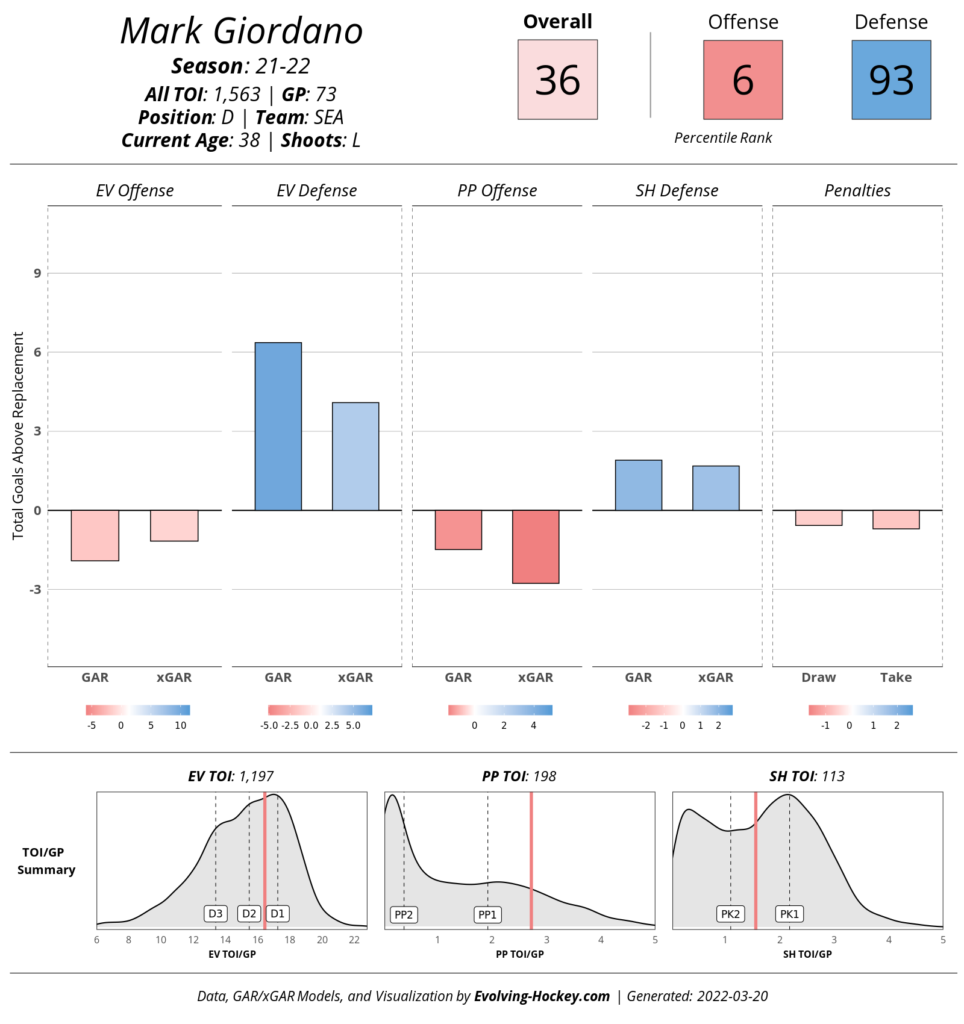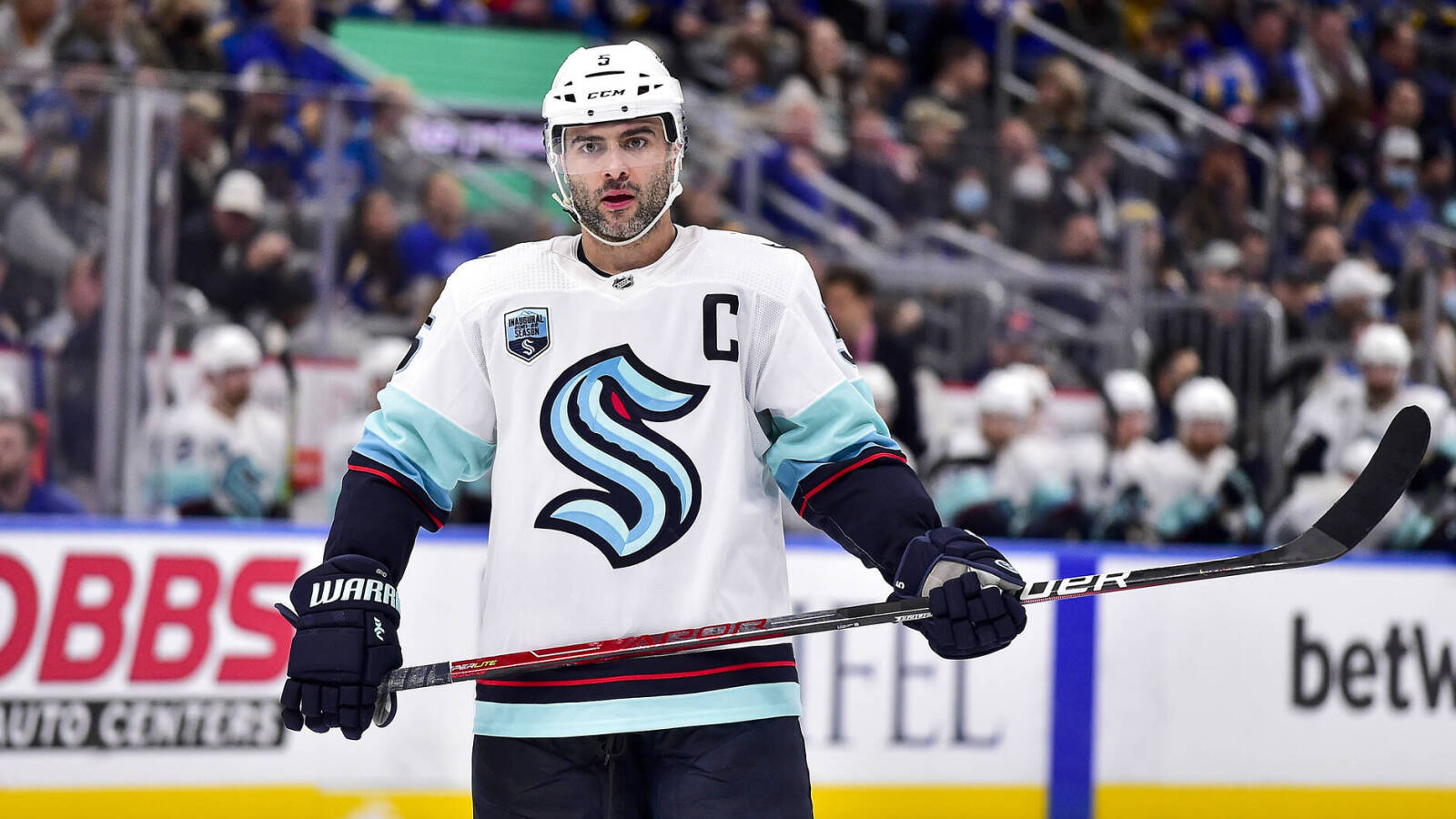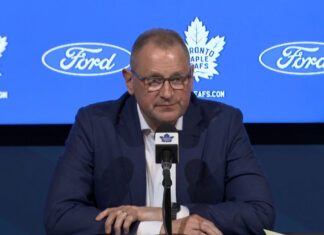A trade that has been talked about in media circles for the past couple of months is now a reality: Mark Giordano has been traded to Toronto Maple Leafs from the Seattle Kraken.
Credit to Ryan Leslie for the scoop, with the return still-to-be-determined:
I believe Giordano has been traded to Toronto.
— Ryan Leslie (@ryanlesliemedia) March 20, 2022
Giordano is a former Norris Trophy winner who is now 38-years-old. Though the veteran defenseman has declined in his offensive game relative to his 2019 Norris win, all indicators point to him still being an excellent defensive defenseman.
Giordano spent the first 15 years of his career in Calgary, where he ranks second in franchise history in games played. He received Norris votes every season from 2013-14 to 2018-19, but his age and contract ($6.9 M cap hit) led the Flames to expose Giordano in the 2021 expansion draft. The Seattle Kraken, looking for a respected leader to become the first captain in franchise history, picked Giordano and gave him the “C” on the sweater. However, the first season in Kraken history has been lackluster, and that put Giordano squarely on the trading block.
It was reported that Giordano, a Toronto native, wanted to be dealt to the Maple Leafs earlier in the week, and the fit makes considerable sense given the injury and struggles of Jake Muzzin. When Giordano won the Norris, he was a high-end offensive threat, both at even strength and on the power play, in addition to a minutes-munching machine. He scored 17 goals and 57 assists for 74 points that season while playing 24:14 ATOI, and he was a consistent 40-50 point threat who was also an easy bet to play between 23 and 25 minutes per night during his prime years:
Mark Giordano Statistics
| S | Team | League | GP | G | A | TP | PIM | +/- | POST | GP | G | A | TP | PIM | +/- | |
|---|---|---|---|---|---|---|---|---|---|---|---|---|---|---|---|---|
| 2005-06 | Calgary Flames | NHL | 7 | 0 | 1 | 1 | 8 | 2 | | | |||||||
| Omaha Ak-Sar-Ben Knights | AHL | 73 | 16 | 42 | 58 | 141 | -1 | | | ||||||||
| 2006-07 | Calgary Flames | NHL | 48 | 7 | 8 | 15 | 36 | 7 | | | Playoffs | 4 | 1 | 0 | 1 | 0 | -1 |
| Omaha Ak-Sar-Ben Knights | AHL | 5 | 0 | 2 | 2 | 8 | 4 | | | Playoffs | 3 | 0 | 1 | 1 | 2 | -3 | |
| 2007-08 | Dynamo Moskva | Russia | 50 | 4 | 8 | 12 | 89 | 3 | | | Playoffs | 9 | 1 | 5 | 6 | 35 | -3 |
| Canada | WC | 0 | 0 | 0 | 0 | 0 | 0 | | | ||||||||
| 2008-09 | Calgary Flames | NHL | 58 | 2 | 17 | 19 | 59 | 2 | | | |||||||
| 2009-10 | Calgary Flames | NHL | 82 | 11 | 19 | 30 | 81 | 17 | | | |||||||
| Canada | WC | 7 | 3 | 1 | 4 | 10 | 2 | | | ||||||||
| 2010-11 | Calgary Flames | NHL | 82 | 8 | 35 | 43 | 67 | -8 | | | |||||||
| 2011-12 | Calgary Flames “A” | NHL | 61 | 9 | 18 | 27 | 75 | 0 | | | |||||||
| 2012-13 | Calgary Flames “A” | NHL | 47 | 4 | 11 | 15 | 40 | -7 | | | |||||||
| 2013-14 | Calgary Flames “C” | NHL | 64 | 14 | 33 | 47 | 63 | 12 | | | |||||||
| 2014-15 | Calgary Flames “C” | NHL | 61 | 11 | 37 | 48 | 37 | 13 | | | |||||||
| 2015-16 | Calgary Flames “C” | NHL | 82 | 21 | 35 | 56 | 54 | -5 | | | |||||||
| 2016-17 | Calgary Flames “C” | NHL | 81 | 12 | 27 | 39 | 59 | 22 | | | Playoffs | 4 | 0 | 1 | 1 | 2 | -2 |
| 2017-18 | Calgary Flames “C” | NHL | 82 | 13 | 25 | 38 | 63 | 0 | | | |||||||
| 2018-19 | Calgary Flames “C” | NHL | 78 | 17 | 57 | 74 | 69 | 39 | | | Playoffs | 5 | 0 | 2 | 2 | 0 | -3 |
| 2019-20 | Calgary Flames “C” | NHL | 60 | 5 | 26 | 31 | 34 | 2 | | | Playoffs | 10 | 0 | 3 | 3 | 12 | -1 |
| 2020-21 | Calgary Flames “C” | NHL | 56 | 9 | 17 | 26 | 14 | 5 | | | |||||||
| 2021-22 | Seattle Kraken “C” | NHL | 55 | 6 | 17 | 23 | 47 | -21 | | | |||||||
| Projected | NHL | 74 | 8 | 23 | 31 | 63 | -28 | | |
As the table shows, Giordano isn’t nearly the puck mover he once was offensively, and his time on ice has declined — understandable for someone who is now 38. The advanced metrics line up with this, but they emphasize how good Giordano still is defensively. Let’s start with his player card from Evolving Hockey:  Giordano’s offensive numbers are very poor, especially on the power play, but that is of less concern to the Toronto Maple Leafs. Morgan Rielly and Rasmus Sandin quarterback the two power-play units, while several other defensemen are quietly strong offensively at 5v5, including the injured Jake Muzzin and Timothy Liljegren. In bringing Giordano to Toronto, the Leafs are studying his defensive metrics, both at even strength and on the penalty kill, and he is excellent in that facet of the game. Giordano has played a sizable role on the PK in Seattle, and he will likely do so in Toronto as well.
Giordano’s offensive numbers are very poor, especially on the power play, but that is of less concern to the Toronto Maple Leafs. Morgan Rielly and Rasmus Sandin quarterback the two power-play units, while several other defensemen are quietly strong offensively at 5v5, including the injured Jake Muzzin and Timothy Liljegren. In bringing Giordano to Toronto, the Leafs are studying his defensive metrics, both at even strength and on the penalty kill, and he is excellent in that facet of the game. Giordano has played a sizable role on the PK in Seattle, and he will likely do so in Toronto as well.
Additionally, it’s worth considering that Giordano’s offensive metrics at 5v5 should improve while playing on a much better offensive team like the Leafs. Giordano’s offensive metrics declined as the team he was playing on declined in quality (age is a factor too, obviously), going from a Flames team that finished with the West’s best record when he won the Norris to a declining Calgary team (pre-Sutter), and now to a bottom feeder expansion team. Going to a contending Leafs team with a top-tier offense will represent a sea change.
From a visual analytics perspective, Giordano does well to lock down the defensive zone and push play out of high danger areas:
Mark Giordano (traded to Toronto) is a good defensive player, both at 5v5 and 4v5, with a very good shot. pic.twitter.com/xKVZdReeP8
— Micah Blake McCurdy (@IneffectiveMath) March 20, 2022
That is something I had liked when I researched Giordano before the deadline. Per Natural Stat Trick, Giordano has been on ice for 8.96 high danger chances against per 60 at 5v5, well below Seattle’s team average of 9.79. The Leafs allow 10.71 per game on average — the major analytics hole in the team’s defense. Much of the goaltending malaise that has hit Toronto in the last couple of months has come from a rapidly declining save percentage on high danger chances against at 5v5, so acquiring a defenseman who can specialize in suppressing those chances feels like a very good fit.
Giordano is not sheltered, either. His most common defensive partner is Jamie Oleksiak, which is the more defensively-oriented of the top two pairs that Seattle rolls out (contrasted with Adam Larsson and Vince Dunn). How does Giordano produce these defensive results? Here’s a short scouting window into his game:
Toronto Maple Leafs make a deal for Mark Giordano. Some quick thoughts…
*Shuts down cycle plays
*Wins battles in DZ, rarely turns the puck over
*Snaps a good first pass pic.twitter.com/GUjXpPwxFj— Mike Kelly (@MikeKellyNHL) March 20, 2022
For those interested in seeing more game tape of Giordano, here is a highlight compilation from last season:
And some scouting from the 2019-20 McKeen’s Yearbook:
Mid-size rearguard is well-constructed with a large wingspan .. strong puckhandler and a resourceful, heads-up puckmover .. strong, balanced skater with decent footspeed .. smooth moving laterally .. pivots and transitions well .. distributes intelligently across the slot line .. proficient walking the line and getting shots through traffic to the net
Giordano fits like a glove in terms of what Toronto will want him to do. The question is how he will fit in the lineup.
The Maple Leafs’ shutdown pair recently has been TJ Brodie and Justin Holl, and it must be assumed that Giordano will slide onto that pair. The two options both make some sense. On one hand, Giordano and TJ Brodie have a ton of history together, spending 10 seasons together in Calgary, including many on the same pair. When Giordano won the Norris, the two played over 1,000 minutes at 5v5 together as a pairing, posting a 53.14% xGF%, with even better possession numbers. That can work well and the two have chemistry.
On the other hand, the Leafs may want to reunite Brodie with Morgan Rielly. Before Jake Muzzin’s first concussion in January, those two had played 91 games together between the last two seasons, posting a 53.4% xGF% at 5v5 as a tandem across the two seasons. Since the injury to Muzzin, those two were forced to take tougher defensive assignments and their results suffered considerably (45.0% xGF% since Muzzin’s first injury).
Acquiring Giordano means the Leafs could slide him next to Holl on the shutdown pair, filling the void created by Muzzin, and then restore Brodie next to Rielly, giving them two rock-solid pairs. That would then give the Leafs the ability to erect a third pair consisting of some combination of Rasmus Sandin, Timothy Liljegren, Ilya Lyubushkin, and (when healthy) Jake Muzzin.
It would seem that the prospect of playing Tampa Bay and their superstar forwards, or Florida and their historically great 5v5 offense, swayed Kyle Dubas into chasing a defensive defenseman like Giordano. After this acquisition, all four teams in the Atlantic Division have saddled up before the trading deadline, with Tampa acquiring Brandon Hagel, Florida acquiring Ben Chiarot, Claude Giroux, and Robert Hagg, and Boston acquiring Hampus Lindholm. The Atlantic Division playoffs are set to be bruising and tight, and a player like Mark Giordano makes the Maple Leafs better suited to deal with the challenges of coming out of the division.
It remains to be seen if there will be another trade or two (perhaps a reserve goalie? fourth-line forward?) up the sleeve of Dubas before the bell rings tomorrow afternoon.

































